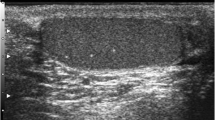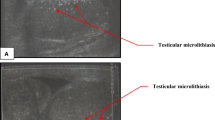Abstract
Purpose
The aims of this study were to evaluate the association of testicular microlithiasis with testicular neoplasm, to assess the accuracy of ultrasonography (US) in comparison with histology in detecting microlithiasis, and to identify the prevalent cytohistological features that accompany testicular cancer.
Materials and methods
Between 2004 and 2005, 14 patients were referred to us for US examination, 13 of whom underwent surgery for testicular cancer. Their age ranged from 19 to 43 years, except for one patient aged 60. US findings and histological examination were compared to assess the accuracy of US in detecting microlithiasis associated with testicular cancer.
Results
In two patients (15.3%), microlithiasis had been detected in a previous US examination, and two patients (15.3%) had altered sperm function. At US examination, testicular cancer was associated with microlithiasis in seven out of 13 patients (53.8%) (the distribution pattern of microlithiasis was intranodular in two, perinodular in two and both intra-and perinodular in three), and colour-Doppler US showed perinodular and intranodular vascularity. Histological evaluation identified nine seminomas, two mixed germ-cell tumours, one embryonal carcinoma, one yolk-sac tumour and one benign Sertoli-cell tumour. In nine (69.2%) patients, microlithiasis was confirmed at histologic evaluation, and its distribution was intranodular in two, perinodular in five and both intra-and perinodular in two. Tubular hyalinisation was demonstrated in 12 out of 13 patients (92.3%).
Conclusions
Testicular microlithiasis and poor sperm function represent risk factors for testicular cancer: in our study, 30.6% of the patients who developed cancer presented these features. At US examination, testicular microlithiasis is often associated with testicular cancer (53.8%). A high accuracy has been demonstrated for US in detecting microlithiasis (53.8%) compared with histological evaluation (69.2%). At histology, tubular hyalinisation (92.3% of cases) is, with testicular microlithiasis, the most frequent finding in the parenchyma adjacent to testicular cancer.
Riassunto
Obiettivo
Analizzare se esistono correlazioni fra la microlitiasi testicolare e le neoplasie testicolari maligne e valutare l’affidabilità dell’ecografia nel rilevare la microlitiasi confrontandola con l’esame istologico; ricercare quali siano gli aspetti citoistologici prevalenti di accompagnamento alla eteroplasia testicolare.
Materali e metodi
Dal 2004 al 2005, sono giunti alla nostra osservazione e sottoposti ad indagine ecografica 14 pazienti, di cui 13 operati per neoplasia maligna, di età compresa tra 19 e 43 anni e solo un caso di 60 anni. Abbiamo comparato l’affidabilità dell’esame ecografico ed istologico nel rilevare le microlitiasi testicolari associate alla neoplasia testicolare maligna.
Risultati
Due pazienti (15,3%) presentavano microlitiasi testicolare in precedente indagine ecografica e due pazienti (15,3%) presentavano alterazioni dello spermiogramma. All’indagine ecografica la neoplasia testicolare maligna nel 53,8% (7/13) era associata alla presenza di microlitiasi testicolare (in 2/7 in sede intranodulare, in 2/7 in sede perinodulare e in 3/7 casi in sede peri-intranodulare) e presentava vascolarizzazione peri ed intranodulare all’eco color doppler. All’esame istologico, 9 risultarono seminomi, 2 forme miste, 1 carcinoma embrionario, 1 tumore del sacco vitellino e 1 tumore a cellule di Sertoli sottotipo sclerosante. In 9 casi su 13 (69,2%) di neoplasie testicolari maligne, sono state rilevate microcalcificazioni (in 2/9 intranodulare, in 5/9 perinodulari e in 2/9 peri ed intranodulari). In 12/13 casi (92,3%) era presente scleroialinosi dei tubuli.
Conclusioni
Le microlitiasi testicolari e le alterazioni del liquido seminale rappresentano fattore di rischio nelle neoplasie maligne del testicolo: infatti, complessivamente, il 30,6% ha sviluppato una eteroplasia maligna. All’indagine ecografica, le microlitiasi testicolari sono spesso presenti (53,8%) in accompagnamento alle neoplasie testicolari maligne. È stata rilevata buona attendibilità dell’ecografia nel rilevare la microlitiasi testicolare (53,8%) rispetto l’esame istologico (69,2%). La scleroialinosi dei tubuli (presente nel 92,3% dei casi) appare, insieme alla microlitiasi testicolare, il reperto più frequente nel parenchima adiacente alla eteroplasia testicolare maligna.
Similar content being viewed by others
References/Bibliografia
Hobarth K, Susani M, Szabo N, Kratzik C (1992) Incidence of testicular microlithiasis. Urology 40:464–467
Nistal M, Paniagua R, Diez-Pardo JA (1979) Testicular microlithiasis in two children with bilateral cryptorchidism. J Urol 121:535–537
Cast JE, Nelson WM, Early AS et al (2000) Testicular microlithiasis: prevalence and tumor risk in a population referred for scrotal sonography. AJR Am J Roentgenol 175:1703–1706
Miller FN, Rosairo S, Clarke JL et al (2007) Testicular calcification and microlithiasis: association with primary intra-testicular malignancy in 3477 patients. Eur Radiol 17:363–369. DOI 10.1007/s00330-006-0296-0
Peterson AC, Bauman JM, Light DE et al (2001) The prevalence of testicular microlithiasis in an asymptomatic population of men 18 to 35 years old. J Urol 166:2061–2064
Kim B, Winter TC 3rd, Ryu JA (2003) Testicular microlithiasis: clinical significance and review of the literature. Eur Radiol 13:2567–2576
Derogee M, Bevers R, Prins H et al (2001) Testicular microlithiasis, a premalignant condition: prevalence, histopatologic findings, and relation to testicular tumor. Urology 57:1133–1137
Backus ML, Mack LA, Middleton WD et al (1994) Testicular microlithiasis: imaging appearances and pathologic correlation. Radiology 192:781–785
Blasetti M, De Rocco L, Bagnato R (1994) La microlitiasi testicolare. Aspetti ecografici e istologici. Radiol Med 87:898–900
Diekmann K, Pichlmeier U (2004) Clinical epidemiology of testicular germ cell tumors. World J Urol 22:2–14
Laguna P, Pizzoccaro G, Klepp O et al and the EAU Working Group on Oncological Urology (2001) EAU guidelines on testicular cancer. Eur Urol 40:102–110
Nistal M, Panigua R (1997) Non neoplastic diseases of the testis. In: Bostwick DG, Eble JN (eds) Urologic Surgical Pathology. Mosby, Boston, pp 501–505
Bunge R, Bradbury J (1961) Intratubular bodies of the human testis. J Urol 85:306–310
Vegni-Talluri M, Bigliardi E, Vanni MG, Tota G (1980) Testicular microliths: their origin and structure. J Urol 124:105–107
Nistal M, Martinez-Garcia C, Paniagua R (1995) The origin of testicular microliths. Int J Androl 18:221–229
Drut R, Drut RM (2002) Testicular microlithiasis: histologic and immunohistochemical findings in 11 pediatric cases. Pediatr Dev Pathol 5:544–550
Renshaw A (1998) Testicular calcifications: incidence, histology and proposed pathological criteria for testicular microlithiasis. J Urol 160:1625–1628
Puttemans T (1999) Doppler Couleur du scrotum, Sauramps Medical, Montpellier France
Middleton WD, Teefev SA, Santillan CS (2002) Testicular microlithiasis: prospective analysis of prevalence and associated tumor. Radiology 224:425–428
Otite U, Webb JA, Oliver RT et al (2001) Testicular microlithiasis: is it a begnin condition with malignant potential? Eur Urol 40:538–542
Lopez Laur JD, Chiapetta Menendez J, Anchelerguez Moreno R, Prats Roma J (2002) Intratesticular calcifications: clinical significance. Actas Urol Esp 26:92–97
Bach AM, Hann LE, Shi W et al (2003) Is there an increased incidence of contralateral testicular cancer in patients with intratesticular microlithiasis? AJR Am J Roentgenol 180:497–500
Ringdahl E, Claybrook K, Teague JL, Northrup M (2004) Testicular microlithiasis and its relation to testicular cancer on ultrasound findings of symptomatic men. J Urol 172:1904–1906
de Gouveia Brazao CA, Pierik FH, Oosterhuis JW et al (2004) Bilateral testicular microlithiasis predicts the presence of the precursor of testicular germ cell tumors in subfertile men. J Urol 171:158–160
Silvani M, Bossola PC, Pagani G, Minocci D (2002) Testicular microlithiasis: unusual ultrasound finding. Arch Ital Urol Androl 74:238–240
Von Eckardstein S, Tsakmakidis G, Kamischke A et al (2001) Sonographic testicular microlithiasis as an indicator of premalignant conditions in normal and infertile men. J Androl 22:818–824
Derogee M, Bevers RF, Prins HJ et al (2001) Testicular microlithiasis, a premalignant condition: prevalence, histopatologic findings, and relation to testicular tumor. Urology 57:1133–1337
Guzman Martinez-Valls PL, Hita Villaplana G, Fernandez Aparicio T et al (2003) Significance and management of testicular microlithiasis. Arch Esp Urol 56:472–477
Bach AM, Hann LE, Hadar O et al (2001) Testicular microlithiasis: what is its association with testicular cancer? Radiology 220:70–75
Heinemann V, Frey U, Linke J, Dieckmann KP (2003) Testicular microlithiasis — one case and four points to note. Scand J Urol Nephrol 37:515–518
Rashid HH, Cos LR, Weinberg E, Messing EM (2004) Testicular microlithiasis: a review and its association with testicular cancer. Urol Oncol 22:285–289
Pourbagher MA, Kiline F, Guvel S et al (2005) Follow-up of testicular microlithiasis for subseguent testicular cancer development. Urol Int 74:108–112
Kocaoglu M, Bozlar U, Bulakbasi N et al (2005) Testicular microlithiasis in pediatric age group: ultrasonography findings and literature review. Diagn Interv Radiol 11:60–65
Bennett HF, Middleton WD, Bullock AD, Teefev SA (2001) Testicular microlithiasis: US follow-up. Radiology 218:359–363
Skyrme RJ, Fenn NJ, Jones AR, Bowsher WG (2000) Testicular microlithiasis in a UK population: its incidence, associations and follow-up. BJU Int 86:482–485
Ravichandran S, Smith R, Cornford PA, Fordham MV (2006) Surveillance of testicular microlithiasis? Results of an UK based national questionnaire survey. BMC Urology 6:8. DOI 10:1186/1471-2490-6-8
Summaria V, Valentini AL, Goletti S et al (1996) Testicular microlithiasis: diagnostic implications in diffuse and focal forms; atti “International Uroradiology 96”, Zurigo 16–20 giugno 1996, p 14
Trias I, Algaba F, Hocsman H (1991) Intratubular germ cell tumor. Eur Urol 19:81–84
Johnson DE, Fueger JJ, Alfaro PJ et al (1987) Subfertility: an etiologic factor in development of testicular cancer? Urology 30:199–200
Berthelsen JG, Skakkebaek NE (1983) Gonadal function of men with testes cancer. Fertil Steril 39:68–75
Thomas K, Wood SJ, Thompson AJM et al (2000) The incidence and significance of testicular microlithiasis in a subfertile population. Brit J Radiol 73:494–497
Author information
Authors and Affiliations
Corresponding author
Rights and permissions
About this article
Cite this article
Parenti, G.C., Zago, S., Lusa, M. et al. Association between testicular microlithiasis and primary malignancy of the testis: our experience and review of the literature. Radiol med 112, 588–596 (2007). https://doi.org/10.1007/s11547-007-0165-1
Received:
Accepted:
Published:
Issue Date:
DOI: https://doi.org/10.1007/s11547-007-0165-1




